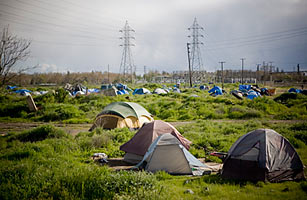
After her husband left her, Jennifer Santana lost her job. When she was evicted from her apartment, Santana, 37, held her family together by living with a friend and then in her van. But as the nights grew cold in early December, she stood huddled with her three children in front of the Orange County cold-weather shelter in Santa Ana, Calif. “There were long lines of men and women, and the people were laying out mats on the floor. It was scary. I could not believe I was standing there with my kids.”
In America’s communities, the local homeless shelter is just one step away from life on the street. Fortunately for Santana’s and other families, county and United Way funds pay for adults with children 18 and younger to be immediately housed in motels. Six weeks after moving into a motel, a small, unheralded federal program — the Homeless Prevention and Rapid Re-Housing Program — began helping Santana move into an apartment. “I am so excited. Things are going to be normal again,” says Santana, a short-haired blond who has found work as a licensed vocational nurse.
Equipped with $1.5 billion of the nearly $800 billion stimulus package, the HPRP started giving out funds in October that some experts believe will help an estimated 600,000 Americans avoid homelessness. The program helps people pay security deposits, utility bills, moving bills and rent checks to either avoid eviction or move from transitional housing into their own apartments. The assistance lasts from three to 18 months. People on the verge of homelessness did not qualify for federal assistance previously, says Housing and Urban Development spokesman Brian Sullivan. “Now we are in the prevention game in a way we have never been before.” Says Nan Roman, executive director of the National Alliance to End Homelessness: “The focus is on people who can get right back in the workforce.”
Soup kitchens and shelters are the traditional ways society has looked after the homeless. But homeless advocates argue that making sure people can continue to afford housing is the central issue. “Services not connected to housing do little good,” says Larry Haynes, executive director of Mercy House, the homeless organization that runs the Santa Ana shelter and an array of other programs in Orange County. “Pancake breakfasts provided by the middle and upper class make people feel better, but where are the pancakes the next day?” he adds. “Haiti is a sad reminder that having a place to live is the base for everything else — for employment, for keeping kids in school, for your health and for your well-being,” says Roman. “In the past, our homeless system did not do much about housing except offer temporary shelter.”